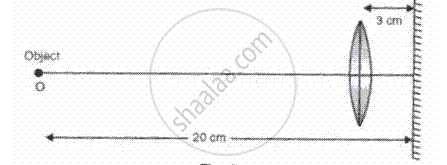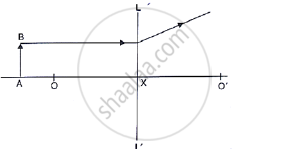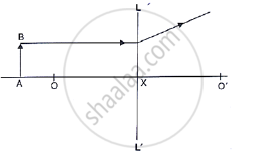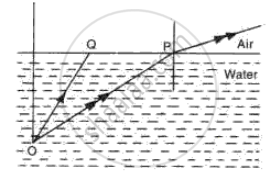Advertisements
Advertisements
Question
Make the rrect choices in the following items :
ln fig, , a real image of a point objert O is formed, Which of the following statements is true about each of the arrangements?

(i) The object is at the principle focus of the lens
(ii) The focal length of the lens is 17 cm
(iii) lf the mirror is moved so that it is 6 cm from the lens image will also move
Solution
(i) The object is at the principle focus of the lens
(ii) The focal length of the lens is 17 cm
(iii) lf the mirror is moved so that it is 6 cm from the lens image will also move
APPEARS IN
RELATED QUESTIONS
What is a lens?
A ray of light incident on a lens parallel to its principal axis, after refraction passes through or appears to come from ______.
Study the diagram shown in Fig. 5.56
Complete the diagram to show the formation of image A’B’ of the object AB of same size.

Study the diagram shown in Fig. 5.56
where is the object located?

The diagram given below shows the position of an object OA in relation to a converging lens whose foci are at F1 and F2.

Describe how the distance of the image from the lens and the size of the image change as the object is moved towards F1.
A ray of light incident at the optical centre of lens, passes undeviated after refraction.
What type of lenses are used in spectacles worn by an old lady for knitting?
Make the correct choices in the following items :
A lens used as a magnifying glass
(i) ls a diverging lens
(ii) Produces a virtual image
(iii) ls placed with the object nearer the lens than the principle focus
Fig. shows two rays of light Op and OQ coming from an object at the bottom of a pond, incident on the water surface.

(a) Mark on the diagram
(i) The angle of incidence of ray OP,
(ii) The angle of refraction of ray Op,
(iii) The position of image of the object as seen from above.
(iv) An approximate path of the ray OQ.
(b) Explain, why do the rays of light change directions on passing from water to air.
(c) A fish in water sees everything outside the water by rays of light entering its eye in a small cone of light. Draw a diagram and explain how does this happen.
